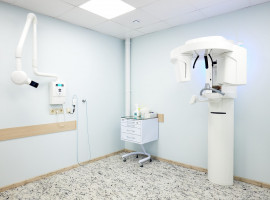Failure to Diagnose Infection Leads to Sepsis and a Malpractice Suit Against OMS
Case Study
Robert A. Strauss, DDS, MD, FACS
March 15, 2022
Reading time: 6 minutes

Background
When complications persist and do not respond to routine therapies, it is incumbent on the OMS to consider alternative and less common diagnoses. When appropriate, referral to a tertiary care center for consultation should be considered. This case illustrates how seemingly routine cases can become malpractice allegations.
Case Discussion
The patient was a 53-year-old female who presented to her general dentist, Dr. M, for treatment of pain in the upper left quadrant. The medical history was only significant for a permanent work-related partial disability. The social history revealed a 1 PPD smoking history and 3-6 drink per day alcohol history.
After examination, Dr. M scheduled the patient one week later for extraction of teeth 14 and 15 and prescribed Cephalexin and Darvocet in the interim. The patient returned for that appointment and had the two teeth extracted without incident.
Seven weeks later the patient went back to Dr. M with the complaint of pain and thermal sensitivity in the area of the surgery. X-rays showed no obvious abnormal findings. Thermal testing showed the remaining maxillary dentition in the upper left quadrant was vital and Dr. M diagnosed a likely maxillary sinusitis. He then referred the patient to her primary care physician, Dr. B, for management.
The primary care provider, Dr. B, saw the patient the same day and prescribed Ceftin and analgesics. After two weeks the patient felt no better. She followed up with Dr. B who prescribed a 10-day course of Ciprofloxacin and obtained a CT scan of her sinuses, which revealed no abnormalities.
Another eleven days passed before Dr. M referred the patient to Dr. J, our insured oral and maxillofacial surgeon, who examined the patient, reviewed the CT scans and felt that there was no acute odontogenic infection that required treatment. Dr. J prescribed chlorhexidine and advised the patient to improve her daily oral hygiene. Of note, the patient verbally requested another systemic antibiotic prescription because she was “afraid of getting an infection.” Dr. J explained that she had just come off the 10-day course of Ciprofloxacin and that he felt a further course of empirical systemic antibiotics was not advised.
The patient returned to Dr. M three days later with left sided facial tenderness, pain and swelling. He diagnosed an acute abscess, prescribed Clindamycin, Zofran (for an undocumented reason but presumably for antibiotic-related nausea) and analgesics. Importantly, no surgical management was undertaken at that time. The patient was not seen by Dr. J for another four days, at which time she was found to have stable, continued facial swelling but was subjectively feeling worse. Dr. J then extracted tooth 16 due to new, acute apical periodontitis. Two more days elapsed and the patient again returned to Dr. M who noted continued swelling and sent the patient back to Dr. J.
Dr. J saw the patient that day and took an x-ray. Although he noted no purulence, Dr. J extracted tooth 13 for unknown reasons, debrided the extraction site of 14 and prescribed azithromycin and analgesics. The following day the patient was seen by Dr. J and seemed slightly improved on physical exam. She was scheduled one day later for follow-up with Dr. J, but requested to skip a day and presented two days later. On exam there was decreased facial swelling and pain but she now showed some intraoral breakdown of the wound and bone exposure with granulation tissue. Dr. J’s notes stated “…very inflamed. Pt is getting better, additional surgery not indicated now”. There was no note of the patient being febrile, having chills, or other systemic signs. Nevertheless, she was prescribed clindamycin, chlorhexidine and nystatin. Although she was scheduled for follow-up four days later, due to a national holiday, a family member of the patient called Dr. J to cancel the patient’s appointment because she was having GI issues and mental confusion. She was rescheduled for another appointment four days later but unfortunately, later that same day she was hospitalized for sepsis and endocarditis.
The patient subsequently had multiple strokes, underwent mitral valve replacement and suffered permanent cognitive and physical disabilities. Dr. J was sued for failure to diagnose and properly manage an infection which led to the complications. The patient questioned why she had not been admitted to the hospital for intravenous antibiotics. It is unknown if Dr. J had hospital and admitting privileges at an inpatient hospital.
Risk Management Considerations
Given the significant and permanent nature of the patient’s injury, this is the type of case that may likely result in a malpractice suit. In defending a medical malpractice case, two critical elements are (1) that the physician practiced in full compliance with the standard of care, and (2) that this compliance can be proven. In trials of any type, the jury does not necessarily decide the case based on the facts; rather they decide the case based on the evidence presented to them. As a result, the written narrative of the patient’s treatment experience (as contained in the patient’s health record) is invaluable.
In this case, no cultures were taken to guide the delivered therapy, which led to the use of at least five different antibiotics. After one course of empirical antibiotics, culture and sensitivity testing should have been considered and documented in the patient’s chart. Deviations from what could normally be considered the standard of care should be documented in the patient’s chart along with a clear explanation of the doctor’s reasoning.
Next, a case that is medically defensible can sometimes become indefensible due to a poorly documented chart. In this case, more often than not the notes in the patient’s chart did not explain why some of these procedures and therapies were utilized; it is imperative to document both the actions being taken and the reason for the actions. Failure to do so can make defensing most cases extremely difficult.
Additionally, there were multiple surgical procedures that did not seem to match the original patient complaint. Progressive, serial extractions of teeth not in the original plan due to continuing patient complaints should be a red flag to the surgeon. In situations like these, the surgeon should be extra cautious and documentation of changes to the patient’s complaint, or a change in a course of treatment, is vital.
Finally, it became unclear to all involved which provider was responsible for managing the care and treatment of the patient. It is important that complications are followed and managed by the oral and maxillofacial surgeon. Instead, in this case, the patient continued to follow-up with her primary care provider, Dr. B., which ultimately delayed follow-up and management by Dr. J and allowed for miscommunication and potentially competing treatment therapies (e.g. the use of bacteriostatic and bacteriocidal antibiotics at the same time).
Conclusion
Consider turning your ‘SOAP’ note into a ‘SOARP’ note. The acronym becomes subjective, objective, assessment, REASONING, and plan. Oral and maxillofacial surgery will never be risk free, but taking reasonable steps to minimize your risk can help you practice with confidence. The more your chart can stand on its own, the better.
Note that this case presentation includes circumstances from several different closed cases, in order to demonstrate certain legal and risk management principles, and that identifying facts and personal characteristics were modified to protect identities. The content within is not the original work of MedPro Group but has been published with consent of the author. Nothing contained in this article should be construed as legal, medical, or dental advice. Because the facts applicable to your situation may vary, or the laws applicable in your jurisdiction may differ, please contact your personal or business attorney or other professional advisors if you have any questions related to your legal or medical obligations or rights, state or federal laws, contract interpretation, or other legal questions.
Additional Risk Tips content

Protected: Patient with Permanent Nerve Injury Sues OMS for Not Using CBCT
Risk Tips
Read about a patient who suffers a permanent IAN injury post-extraction and sues the OMS for failing to use a CBCT to assess the injury beforehand.

Patient Blames Oral Surgeon For Trigeminal Neuralgia Diagnosis
Risk Tips
Learn how a seemingly standard root canal procedure can escalate into a trigeminal neuralgia diagnosis and a resulting lawsuit.

Office Manager Gives Unsafe Clinical Advice Without Consulting OMS
Risk Tips
The treating OMS should be the one to give patients clinical advice. Read what happens when an unqualified staff member does instead.
This document does not constitute legal or medical advice and should not be construed as rules or establishing a standard of care. Because the facts applicable to your situation may vary, or the laws applicable in your jurisdiction may differ, please contact your attorney or other professional advisors if you have any questions related to your legal or medical obligations or rights, state or federal laws, contract interpretation, or other legal questions.
MedPro Group is the marketing name used to refer to the insurance operations of The Medical Protective Company, Princeton Insurance Company, PLICO, Inc. and MedPro RRG Risk Retention Group. All insurance products are underwritten and administered by these and other Berkshire Hathaway affiliates, including National Fire & Marine Insurance Company. Product availability is based upon business and/or regulatory approval and/or may differ among companies.
© MedPro Group Inc. All rights reserved.